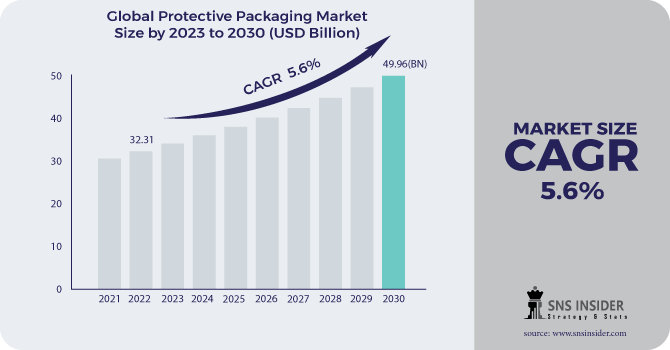Protective Packaging Market Report Scope & Overview:
The Protective Packaging Market Size was valued at USD 32.31 billion in 2022, and is expected to reach USD 49.96 billion by 2030 and grow at a CAGR of 5.6% over the forecast period 2023-2030.
Various applications, including those in the food, electronics, and pharmaceutical industries, embrace protective packaging. According to the type of goods, protective packaging can be divided into three basic categories: rigid, foam, and flexible. Additionally, protective packaging offers solutions that shield machinery, equipment, and industrial goods from harm while being stored and transported. Additionally, protective packaging provides security through void fill, wrapping, flexible cushioning, blocking and bracing, protective containment, and surface defense.

To Get More Information on Protective Packaging Market - Request Sample Report
Market Dynamics
Drivers:
-
APAC's Packaging Industry is Growing
-
Increase in the E-Commerce Sector
Restraints:
-
Packaging is subject to strict regulations.
Opportunity:
-
International Trade and Globalization
Challenge:
-
Efficiency and Sustainability
Impact of Covid-19
Manufacturers and suppliers of protective packaging were heavily impacted by safety and governmental orders made at the federal, state, and local levels in 2020. Companies have been compelled to alter or adapt their regular business activities as a result of federal government (United States) recommendations to stop the virus' spread and Shelter-in-Place Orders issued at the state and local levels. Protective packaging producers suffered in 2020 as a result of laws requiring business closures, societal conventions of segregation, and reduced municipal and state government office activity. The pandemic hindered the need for protective packaging, primarily because the end-use sectors' demand for this protective packaging fell.
Key Market Segmentation
By Type
-
Rigid Protective Packaging
-
Flexible Protective Packaging
-
Foam Protective Packaging
By Material
-
Foam Plastics
-
Plastics
-
Others
By Function
-
Cushioning
-
Blocking & Bracing
-
Void Fill
-
Insulation
-
Wrapping
By Application
-
Food & Beverage
-
Industrial Goods
-
Healthcare
-
Automotive
-
Cushioning
-
Household Appliances
-
Others
.png)
Do You Need any Customization Research on Protective Packaging Market - Inquire Now
Regional Analysis
Due to the growing demand from the e-commerce sector for the security of transported goods, Asia-Pacific now holds a dominant position in the protective packaging market. Protective packaging market growth is anticipated to be aided by increased customer spending, ongoing automation developments, and improved manufacturing activities in the area. The presence of big population economies is fostering the development of the e-commerce sector, which is anticipated to have a positive impact on the growth of the protective packaging market in the region throughout the course of the forecast period. Due to a number of variables, including the expanding middle class, modernity, and the population's disposable income levels, North America is predicted to see a substantial portion of the market expansion for protective packaging.
The national part of the research also lists specific market-impacting variables and domestic market regulation changes that have an affect on the market's present and future tendencies. Some of the key data points used to estimate the market situation for specific nations are consumption volumes, production sites and volumes, import-export analysis, price trend analysis, cost of raw materials, and upstream and downstream value chain analysis. When giving prediction analysis of the country data, it also takes into account the presence and accessibility of international brands, the difficulties they encounter owing to strong or weak competition from local and domestic brands, the influence of domestic tariffs, and trade routes.
REGIONAL COVERAGE:
-
North America
-
USA
-
Canada
-
Mexico
-
-
Europe
-
Germany
-
UK
-
France
-
Italy
-
Spain
-
The Netherlands
-
Rest of Europe
-
-
Asia-Pacific
-
Japan
-
south Korea
-
China
-
India
-
Australia
-
Rest of Asia-Pacific
-
-
The Middle East & Africa
-
Israel
-
UAE
-
South Africa
-
Rest of Middle East & Africa
-
-
Latin America
-
Brazil
-
Argentina
-
Rest of Latin America
-
Key Players:
The Major Players are Cascades Corporation, DS Smith Plc, Huhtamaki OYJ, Pregis Corporation, Pro-Pac Packaging Limited, BASF SE, Rocktenn Company, Sonoco Products Company, The Dow Chemical Company, Sealed Air Corporation & Other Players
DS Smith Plc-Company Financial Analysis

| Report Attributes | Details |
|---|---|
| Market Size in 2022 | US$ 32.31 Billion |
| Market Size by 2030 | US$ 49.96 Billion |
| CAGR | CAGR of 5.6% From 2023 to 2030 |
| Base Year | 2022 |
| Forecast Period | 2023-2030 |
| Historical Data | 2020-2021 |
| Report Scope & Coverage | Market Size, Segments Analysis, Competitive Landscape, Regional Analysis, DROC & SWOT Analysis, Forecast Outlook |
| Key Segments | • By Type (Rigid Protective Packaging, Flexible Protective Packaging, Foam Protective Packaging) • By Material (Foam Plastics, Paper & Paperboard, Plastics, Others) • By Function (Cushioning, Blocking & Bracing, Void Fill, Insulation, Wrapping) • By Application (Food & Beverage, Industrial Goods, Healthcare, Automotive, Cushioning, Household Appliances, Others) |
| Regional Analysis/Coverage | North America (USA, Canada, Mexico), Europe (Germany, UK, France, Italy, Spain, Netherlands, Rest of Europe), Asia-Pacific (Japan, South Korea, China, India, Australia, Rest of Asia-Pacific), The Middle East & Africa (Israel, UAE, South Africa, Rest of Middle East & Africa), Latin America (Brazil, Argentina, Rest of Latin America) |
| Company Profiles | Cascades Corporation, DS Smith Plc, Huhtamaki OYJ, Pregis Corporation, Pro-Pac Packaging Limited, BASF SE, Rocktenn Company, Sonoco Products Company, The Dow Chemical Company, Sealed Air Corporation. |
| DRIVERS | • APAC's Packaging Industry is Growing • Increase in the E-Commerce Sector |
| Restraints | • Packaging is subject to strict regulations. |

